Analyzing Closing the Gap Policy on Aboriginal Health and Wellbeing
VerifiedAdded on 2022/09/07
|8
|2267
|15
Essay
AI Summary
This essay provides a comprehensive overview of the "Closing the Gap" policy in Australia, focusing on its aims to address health disparities among Aboriginal and Torres Strait Islander (ABTSI) people. The essay begins with a summary of the policy, which was initiated in 2008 to address socioeconomic disadvantages and improve health outcomes for Indigenous Australians. It identifies a relevant target within the policy concerning Judy, a 57-year-old widow with diabetes and leg ulcers, focusing on increasing life expectancy. The essay then analyzes three social determinants – age, income, and location – and their impact on Judy's health, highlighting challenges related to access to healthcare and financial constraints. Furthermore, the essay discusses the registration process for Judy under the "Closing the Gap" policy, including the roles of the Remote Area Aboriginal Health Services (RAAHS) and the Pharmaceutical Benefits Scheme. It also defines the roles of the Aboriginal Medical Service (AMS) and the Aboriginal Liaison Officer (ALO), emphasizing their importance in providing culturally sensitive support and improving health outcomes for Indigenous communities. The conclusion reinforces the significance of the "Closing the Gap" strategy in reducing disparities and improving the overall well-being of the ABTSI population.
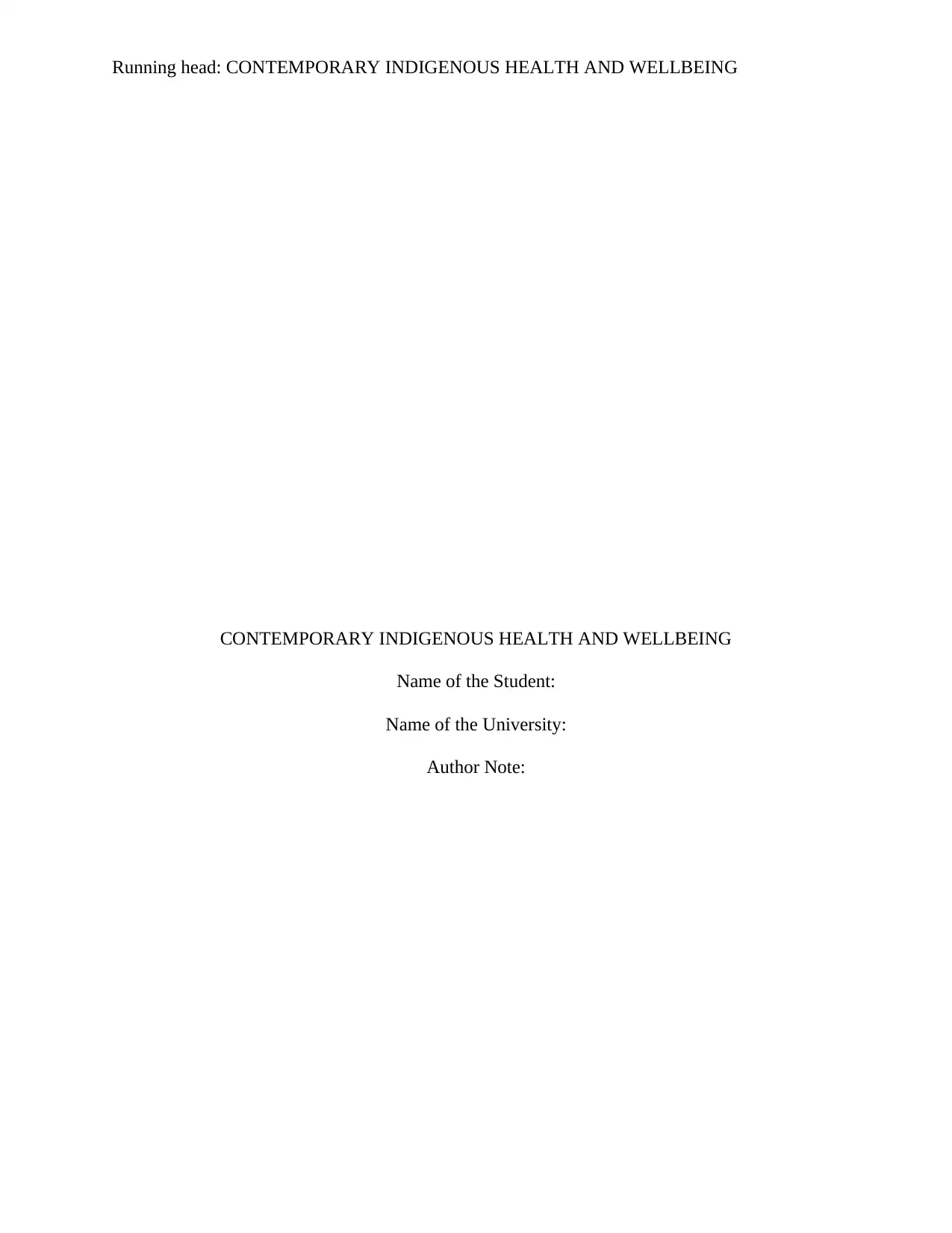
Running head: CONTEMPORARY INDIGENOUS HEALTH AND WELLBEING
CONTEMPORARY INDIGENOUS HEALTH AND WELLBEING
Name of the Student:
Name of the University:
Author Note:
CONTEMPORARY INDIGENOUS HEALTH AND WELLBEING
Name of the Student:
Name of the University:
Author Note:
Paraphrase This Document
Need a fresh take? Get an instant paraphrase of this document with our AI Paraphraser
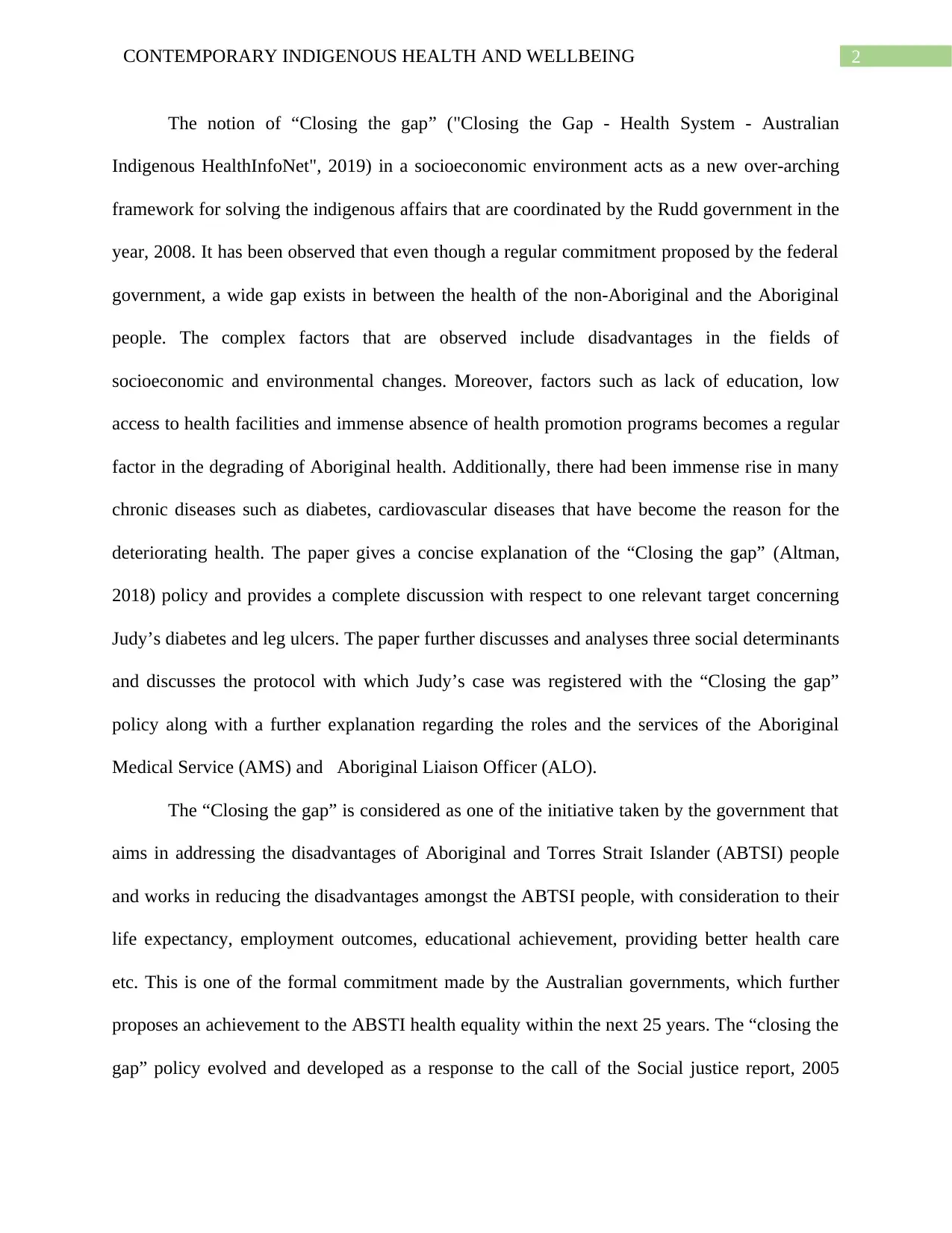
2CONTEMPORARY INDIGENOUS HEALTH AND WELLBEING
The notion of “Closing the gap” ("Closing the Gap - Health System - Australian
Indigenous HealthInfoNet", 2019) in a socioeconomic environment acts as a new over-arching
framework for solving the indigenous affairs that are coordinated by the Rudd government in the
year, 2008. It has been observed that even though a regular commitment proposed by the federal
government, a wide gap exists in between the health of the non-Aboriginal and the Aboriginal
people. The complex factors that are observed include disadvantages in the fields of
socioeconomic and environmental changes. Moreover, factors such as lack of education, low
access to health facilities and immense absence of health promotion programs becomes a regular
factor in the degrading of Aboriginal health. Additionally, there had been immense rise in many
chronic diseases such as diabetes, cardiovascular diseases that have become the reason for the
deteriorating health. The paper gives a concise explanation of the “Closing the gap” (Altman,
2018) policy and provides a complete discussion with respect to one relevant target concerning
Judy’s diabetes and leg ulcers. The paper further discusses and analyses three social determinants
and discusses the protocol with which Judy’s case was registered with the “Closing the gap”
policy along with a further explanation regarding the roles and the services of the Aboriginal
Medical Service (AMS) and Aboriginal Liaison Officer (ALO).
The “Closing the gap” is considered as one of the initiative taken by the government that
aims in addressing the disadvantages of Aboriginal and Torres Strait Islander (ABTSI) people
and works in reducing the disadvantages amongst the ABTSI people, with consideration to their
life expectancy, employment outcomes, educational achievement, providing better health care
etc. This is one of the formal commitment made by the Australian governments, which further
proposes an achievement to the ABSTI health equality within the next 25 years. The “closing the
gap” policy evolved and developed as a response to the call of the Social justice report, 2005
The notion of “Closing the gap” ("Closing the Gap - Health System - Australian
Indigenous HealthInfoNet", 2019) in a socioeconomic environment acts as a new over-arching
framework for solving the indigenous affairs that are coordinated by the Rudd government in the
year, 2008. It has been observed that even though a regular commitment proposed by the federal
government, a wide gap exists in between the health of the non-Aboriginal and the Aboriginal
people. The complex factors that are observed include disadvantages in the fields of
socioeconomic and environmental changes. Moreover, factors such as lack of education, low
access to health facilities and immense absence of health promotion programs becomes a regular
factor in the degrading of Aboriginal health. Additionally, there had been immense rise in many
chronic diseases such as diabetes, cardiovascular diseases that have become the reason for the
deteriorating health. The paper gives a concise explanation of the “Closing the gap” (Altman,
2018) policy and provides a complete discussion with respect to one relevant target concerning
Judy’s diabetes and leg ulcers. The paper further discusses and analyses three social determinants
and discusses the protocol with which Judy’s case was registered with the “Closing the gap”
policy along with a further explanation regarding the roles and the services of the Aboriginal
Medical Service (AMS) and Aboriginal Liaison Officer (ALO).
The “Closing the gap” is considered as one of the initiative taken by the government that
aims in addressing the disadvantages of Aboriginal and Torres Strait Islander (ABTSI) people
and works in reducing the disadvantages amongst the ABTSI people, with consideration to their
life expectancy, employment outcomes, educational achievement, providing better health care
etc. This is one of the formal commitment made by the Australian governments, which further
proposes an achievement to the ABSTI health equality within the next 25 years. The “closing the
gap” policy evolved and developed as a response to the call of the Social justice report, 2005
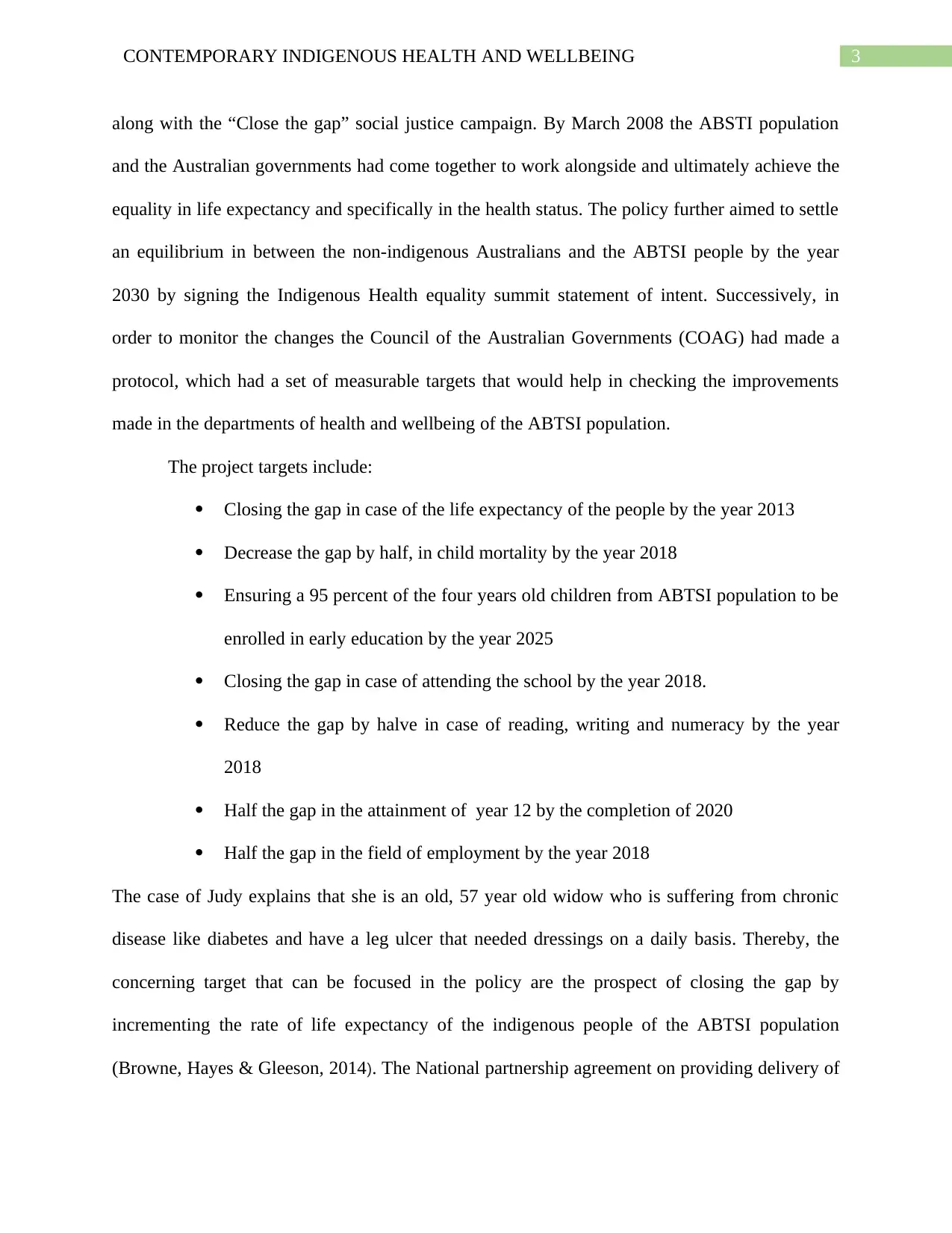
3CONTEMPORARY INDIGENOUS HEALTH AND WELLBEING
along with the “Close the gap” social justice campaign. By March 2008 the ABSTI population
and the Australian governments had come together to work alongside and ultimately achieve the
equality in life expectancy and specifically in the health status. The policy further aimed to settle
an equilibrium in between the non-indigenous Australians and the ABTSI people by the year
2030 by signing the Indigenous Health equality summit statement of intent. Successively, in
order to monitor the changes the Council of the Australian Governments (COAG) had made a
protocol, which had a set of measurable targets that would help in checking the improvements
made in the departments of health and wellbeing of the ABTSI population.
The project targets include:
Closing the gap in case of the life expectancy of the people by the year 2013
Decrease the gap by half, in child mortality by the year 2018
Ensuring a 95 percent of the four years old children from ABTSI population to be
enrolled in early education by the year 2025
Closing the gap in case of attending the school by the year 2018.
Reduce the gap by halve in case of reading, writing and numeracy by the year
2018
Half the gap in the attainment of year 12 by the completion of 2020
Half the gap in the field of employment by the year 2018
The case of Judy explains that she is an old, 57 year old widow who is suffering from chronic
disease like diabetes and have a leg ulcer that needed dressings on a daily basis. Thereby, the
concerning target that can be focused in the policy are the prospect of closing the gap by
incrementing the rate of life expectancy of the indigenous people of the ABTSI population
(Browne, Hayes & Gleeson, 2014). The National partnership agreement on providing delivery of
along with the “Close the gap” social justice campaign. By March 2008 the ABSTI population
and the Australian governments had come together to work alongside and ultimately achieve the
equality in life expectancy and specifically in the health status. The policy further aimed to settle
an equilibrium in between the non-indigenous Australians and the ABTSI people by the year
2030 by signing the Indigenous Health equality summit statement of intent. Successively, in
order to monitor the changes the Council of the Australian Governments (COAG) had made a
protocol, which had a set of measurable targets that would help in checking the improvements
made in the departments of health and wellbeing of the ABTSI population.
The project targets include:
Closing the gap in case of the life expectancy of the people by the year 2013
Decrease the gap by half, in child mortality by the year 2018
Ensuring a 95 percent of the four years old children from ABTSI population to be
enrolled in early education by the year 2025
Closing the gap in case of attending the school by the year 2018.
Reduce the gap by halve in case of reading, writing and numeracy by the year
2018
Half the gap in the attainment of year 12 by the completion of 2020
Half the gap in the field of employment by the year 2018
The case of Judy explains that she is an old, 57 year old widow who is suffering from chronic
disease like diabetes and have a leg ulcer that needed dressings on a daily basis. Thereby, the
concerning target that can be focused in the policy are the prospect of closing the gap by
incrementing the rate of life expectancy of the indigenous people of the ABTSI population
(Browne, Hayes & Gleeson, 2014). The National partnership agreement on providing delivery of
⊘ This is a preview!⊘
Do you want full access?
Subscribe today to unlock all pages.

Trusted by 1+ million students worldwide
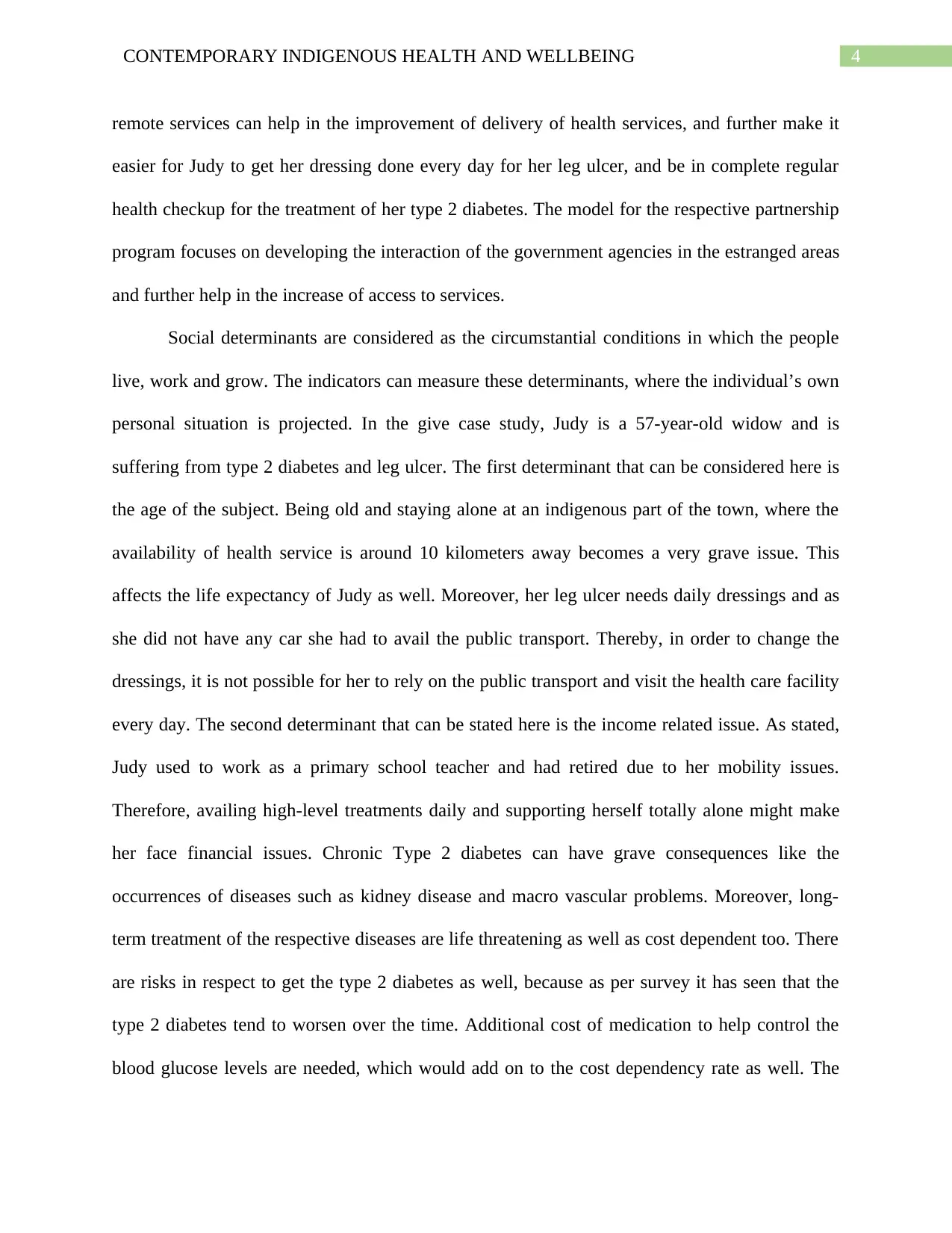
4CONTEMPORARY INDIGENOUS HEALTH AND WELLBEING
remote services can help in the improvement of delivery of health services, and further make it
easier for Judy to get her dressing done every day for her leg ulcer, and be in complete regular
health checkup for the treatment of her type 2 diabetes. The model for the respective partnership
program focuses on developing the interaction of the government agencies in the estranged areas
and further help in the increase of access to services.
Social determinants are considered as the circumstantial conditions in which the people
live, work and grow. The indicators can measure these determinants, where the individual’s own
personal situation is projected. In the give case study, Judy is a 57-year-old widow and is
suffering from type 2 diabetes and leg ulcer. The first determinant that can be considered here is
the age of the subject. Being old and staying alone at an indigenous part of the town, where the
availability of health service is around 10 kilometers away becomes a very grave issue. This
affects the life expectancy of Judy as well. Moreover, her leg ulcer needs daily dressings and as
she did not have any car she had to avail the public transport. Thereby, in order to change the
dressings, it is not possible for her to rely on the public transport and visit the health care facility
every day. The second determinant that can be stated here is the income related issue. As stated,
Judy used to work as a primary school teacher and had retired due to her mobility issues.
Therefore, availing high-level treatments daily and supporting herself totally alone might make
her face financial issues. Chronic Type 2 diabetes can have grave consequences like the
occurrences of diseases such as kidney disease and macro vascular problems. Moreover, long-
term treatment of the respective diseases are life threatening as well as cost dependent too. There
are risks in respect to get the type 2 diabetes as well, because as per survey it has seen that the
type 2 diabetes tend to worsen over the time. Additional cost of medication to help control the
blood glucose levels are needed, which would add on to the cost dependency rate as well. The
remote services can help in the improvement of delivery of health services, and further make it
easier for Judy to get her dressing done every day for her leg ulcer, and be in complete regular
health checkup for the treatment of her type 2 diabetes. The model for the respective partnership
program focuses on developing the interaction of the government agencies in the estranged areas
and further help in the increase of access to services.
Social determinants are considered as the circumstantial conditions in which the people
live, work and grow. The indicators can measure these determinants, where the individual’s own
personal situation is projected. In the give case study, Judy is a 57-year-old widow and is
suffering from type 2 diabetes and leg ulcer. The first determinant that can be considered here is
the age of the subject. Being old and staying alone at an indigenous part of the town, where the
availability of health service is around 10 kilometers away becomes a very grave issue. This
affects the life expectancy of Judy as well. Moreover, her leg ulcer needs daily dressings and as
she did not have any car she had to avail the public transport. Thereby, in order to change the
dressings, it is not possible for her to rely on the public transport and visit the health care facility
every day. The second determinant that can be stated here is the income related issue. As stated,
Judy used to work as a primary school teacher and had retired due to her mobility issues.
Therefore, availing high-level treatments daily and supporting herself totally alone might make
her face financial issues. Chronic Type 2 diabetes can have grave consequences like the
occurrences of diseases such as kidney disease and macro vascular problems. Moreover, long-
term treatment of the respective diseases are life threatening as well as cost dependent too. There
are risks in respect to get the type 2 diabetes as well, because as per survey it has seen that the
type 2 diabetes tend to worsen over the time. Additional cost of medication to help control the
blood glucose levels are needed, which would add on to the cost dependency rate as well. The
Paraphrase This Document
Need a fresh take? Get an instant paraphrase of this document with our AI Paraphraser
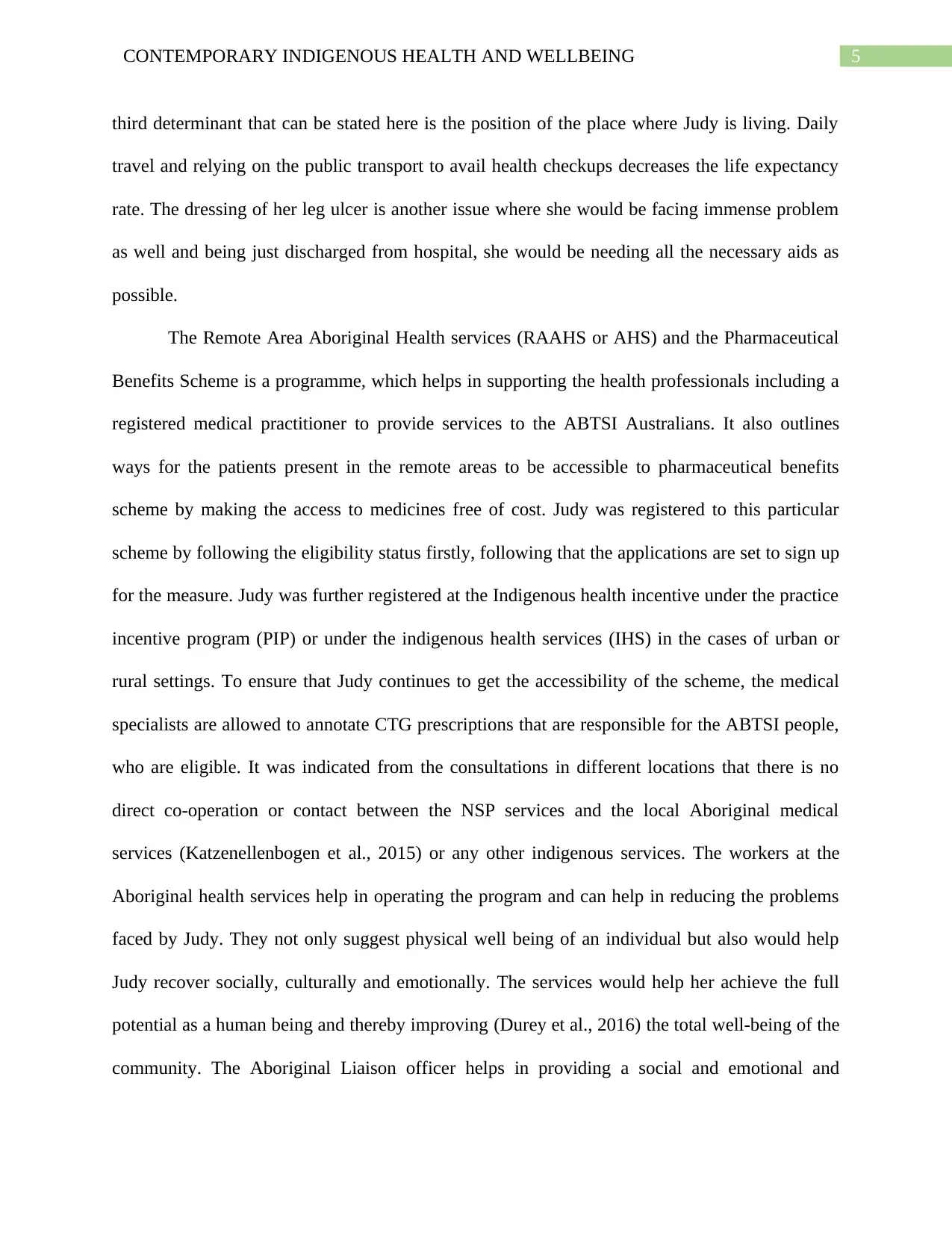
5CONTEMPORARY INDIGENOUS HEALTH AND WELLBEING
third determinant that can be stated here is the position of the place where Judy is living. Daily
travel and relying on the public transport to avail health checkups decreases the life expectancy
rate. The dressing of her leg ulcer is another issue where she would be facing immense problem
as well and being just discharged from hospital, she would be needing all the necessary aids as
possible.
The Remote Area Aboriginal Health services (RAAHS or AHS) and the Pharmaceutical
Benefits Scheme is a programme, which helps in supporting the health professionals including a
registered medical practitioner to provide services to the ABTSI Australians. It also outlines
ways for the patients present in the remote areas to be accessible to pharmaceutical benefits
scheme by making the access to medicines free of cost. Judy was registered to this particular
scheme by following the eligibility status firstly, following that the applications are set to sign up
for the measure. Judy was further registered at the Indigenous health incentive under the practice
incentive program (PIP) or under the indigenous health services (IHS) in the cases of urban or
rural settings. To ensure that Judy continues to get the accessibility of the scheme, the medical
specialists are allowed to annotate CTG prescriptions that are responsible for the ABTSI people,
who are eligible. It was indicated from the consultations in different locations that there is no
direct co-operation or contact between the NSP services and the local Aboriginal medical
services (Katzenellenbogen et al., 2015) or any other indigenous services. The workers at the
Aboriginal health services help in operating the program and can help in reducing the problems
faced by Judy. They not only suggest physical well being of an individual but also would help
Judy recover socially, culturally and emotionally. The services would help her achieve the full
potential as a human being and thereby improving (Durey et al., 2016) the total well-being of the
community. The Aboriginal Liaison officer helps in providing a social and emotional and
third determinant that can be stated here is the position of the place where Judy is living. Daily
travel and relying on the public transport to avail health checkups decreases the life expectancy
rate. The dressing of her leg ulcer is another issue where she would be facing immense problem
as well and being just discharged from hospital, she would be needing all the necessary aids as
possible.
The Remote Area Aboriginal Health services (RAAHS or AHS) and the Pharmaceutical
Benefits Scheme is a programme, which helps in supporting the health professionals including a
registered medical practitioner to provide services to the ABTSI Australians. It also outlines
ways for the patients present in the remote areas to be accessible to pharmaceutical benefits
scheme by making the access to medicines free of cost. Judy was registered to this particular
scheme by following the eligibility status firstly, following that the applications are set to sign up
for the measure. Judy was further registered at the Indigenous health incentive under the practice
incentive program (PIP) or under the indigenous health services (IHS) in the cases of urban or
rural settings. To ensure that Judy continues to get the accessibility of the scheme, the medical
specialists are allowed to annotate CTG prescriptions that are responsible for the ABTSI people,
who are eligible. It was indicated from the consultations in different locations that there is no
direct co-operation or contact between the NSP services and the local Aboriginal medical
services (Katzenellenbogen et al., 2015) or any other indigenous services. The workers at the
Aboriginal health services help in operating the program and can help in reducing the problems
faced by Judy. They not only suggest physical well being of an individual but also would help
Judy recover socially, culturally and emotionally. The services would help her achieve the full
potential as a human being and thereby improving (Durey et al., 2016) the total well-being of the
community. The Aboriginal Liaison officer helps in providing a social and emotional and
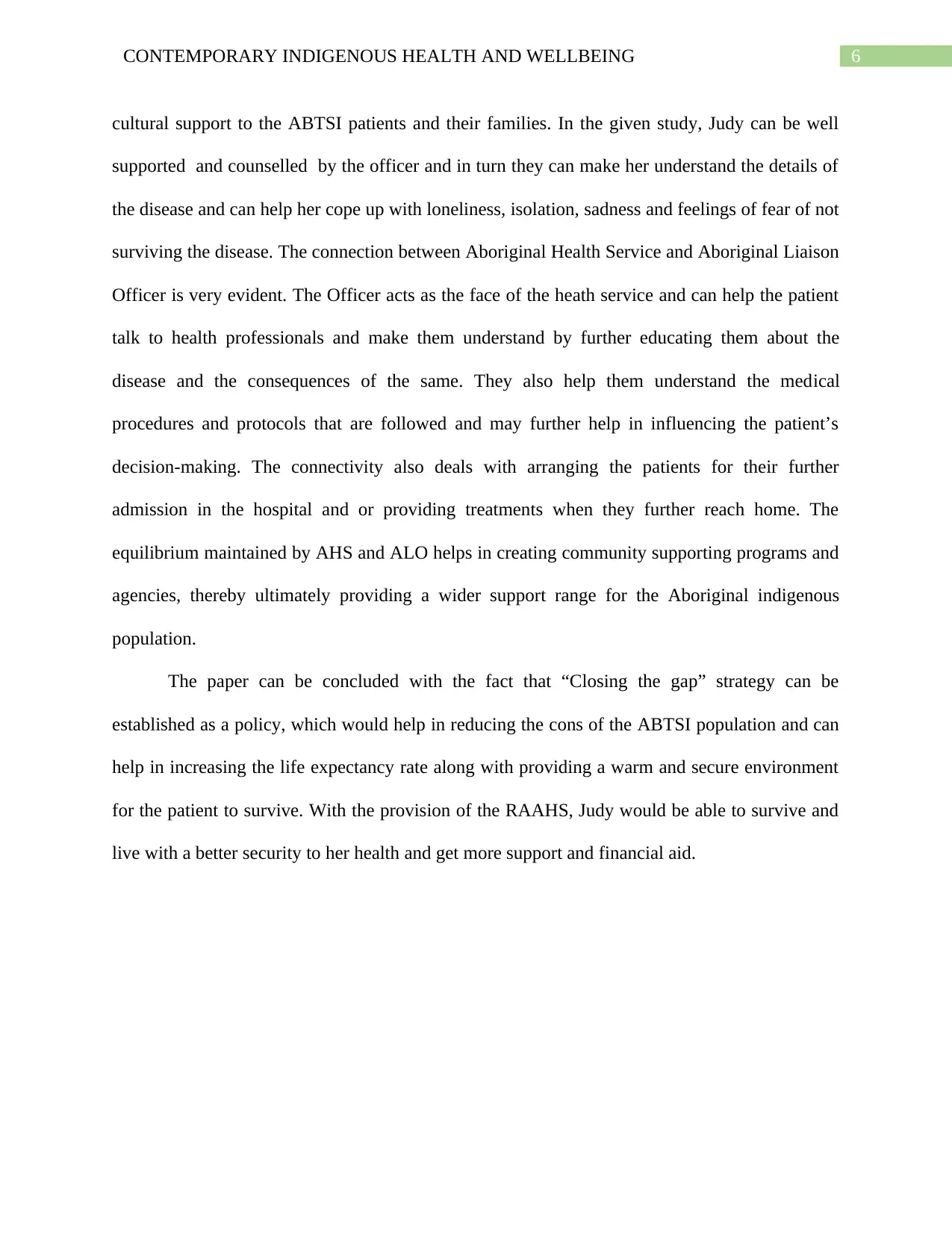
6CONTEMPORARY INDIGENOUS HEALTH AND WELLBEING
cultural support to the ABTSI patients and their families. In the given study, Judy can be well
supported and counselled by the officer and in turn they can make her understand the details of
the disease and can help her cope up with loneliness, isolation, sadness and feelings of fear of not
surviving the disease. The connection between Aboriginal Health Service and Aboriginal Liaison
Officer is very evident. The Officer acts as the face of the heath service and can help the patient
talk to health professionals and make them understand by further educating them about the
disease and the consequences of the same. They also help them understand the medical
procedures and protocols that are followed and may further help in influencing the patient’s
decision-making. The connectivity also deals with arranging the patients for their further
admission in the hospital and or providing treatments when they further reach home. The
equilibrium maintained by AHS and ALO helps in creating community supporting programs and
agencies, thereby ultimately providing a wider support range for the Aboriginal indigenous
population.
The paper can be concluded with the fact that “Closing the gap” strategy can be
established as a policy, which would help in reducing the cons of the ABTSI population and can
help in increasing the life expectancy rate along with providing a warm and secure environment
for the patient to survive. With the provision of the RAAHS, Judy would be able to survive and
live with a better security to her health and get more support and financial aid.
cultural support to the ABTSI patients and their families. In the given study, Judy can be well
supported and counselled by the officer and in turn they can make her understand the details of
the disease and can help her cope up with loneliness, isolation, sadness and feelings of fear of not
surviving the disease. The connection between Aboriginal Health Service and Aboriginal Liaison
Officer is very evident. The Officer acts as the face of the heath service and can help the patient
talk to health professionals and make them understand by further educating them about the
disease and the consequences of the same. They also help them understand the medical
procedures and protocols that are followed and may further help in influencing the patient’s
decision-making. The connectivity also deals with arranging the patients for their further
admission in the hospital and or providing treatments when they further reach home. The
equilibrium maintained by AHS and ALO helps in creating community supporting programs and
agencies, thereby ultimately providing a wider support range for the Aboriginal indigenous
population.
The paper can be concluded with the fact that “Closing the gap” strategy can be
established as a policy, which would help in reducing the cons of the ABTSI population and can
help in increasing the life expectancy rate along with providing a warm and secure environment
for the patient to survive. With the provision of the RAAHS, Judy would be able to survive and
live with a better security to her health and get more support and financial aid.
⊘ This is a preview!⊘
Do you want full access?
Subscribe today to unlock all pages.

Trusted by 1+ million students worldwide
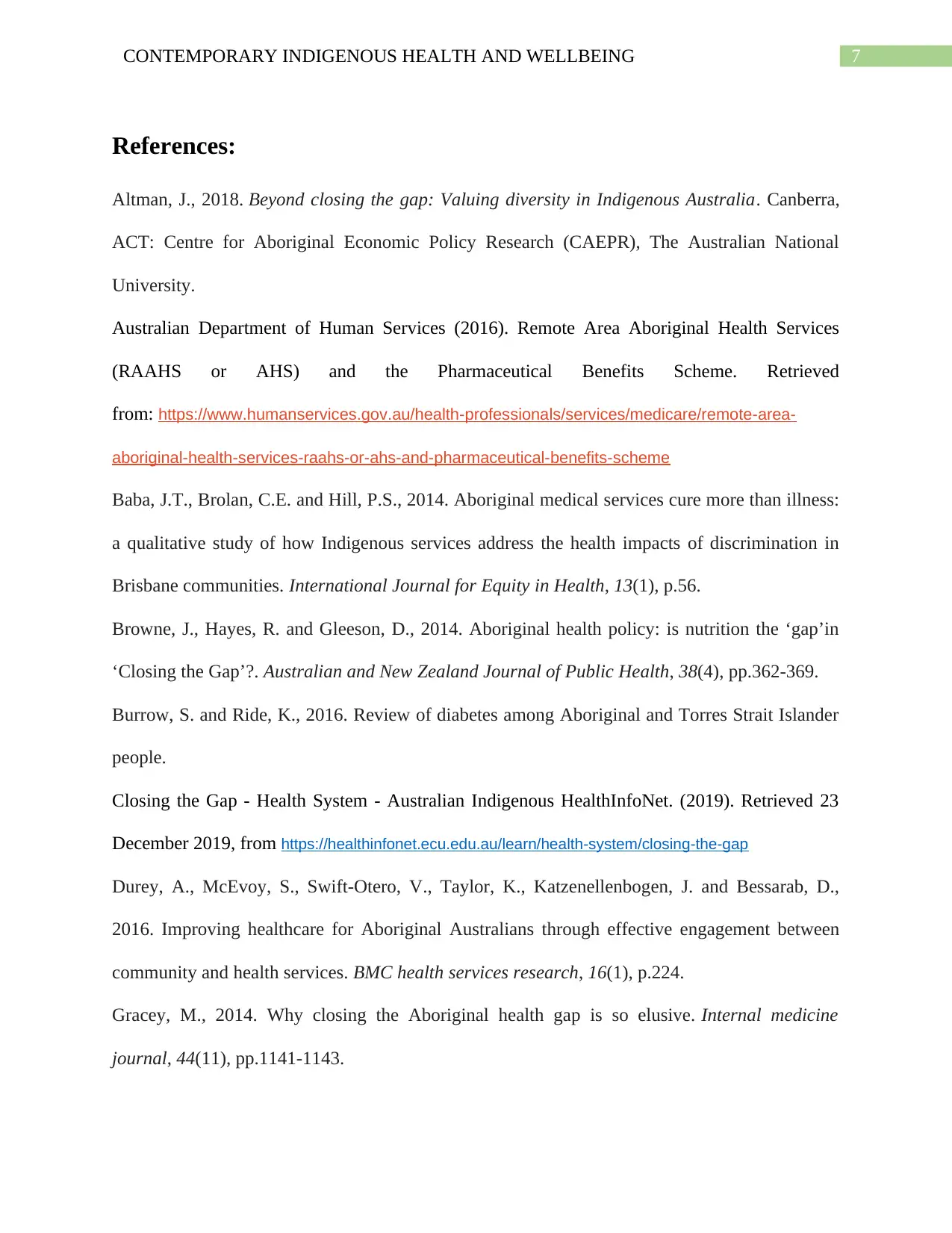
7CONTEMPORARY INDIGENOUS HEALTH AND WELLBEING
References:
Altman, J., 2018. Beyond closing the gap: Valuing diversity in Indigenous Australia. Canberra,
ACT: Centre for Aboriginal Economic Policy Research (CAEPR), The Australian National
University.
Australian Department of Human Services (2016). Remote Area Aboriginal Health Services
(RAAHS or AHS) and the Pharmaceutical Benefits Scheme. Retrieved
from: https://www.humanservices.gov.au/health-professionals/services/medicare/remote-area-
aboriginal-health-services-raahs-or-ahs-and-pharmaceutical-benefits-scheme
Baba, J.T., Brolan, C.E. and Hill, P.S., 2014. Aboriginal medical services cure more than illness:
a qualitative study of how Indigenous services address the health impacts of discrimination in
Brisbane communities. International Journal for Equity in Health, 13(1), p.56.
Browne, J., Hayes, R. and Gleeson, D., 2014. Aboriginal health policy: is nutrition the ‘gap’in
‘Closing the Gap’?. Australian and New Zealand Journal of Public Health, 38(4), pp.362-369.
Burrow, S. and Ride, K., 2016. Review of diabetes among Aboriginal and Torres Strait Islander
people.
Closing the Gap - Health System - Australian Indigenous HealthInfoNet. (2019). Retrieved 23
December 2019, from https://healthinfonet.ecu.edu.au/learn/health-system/closing-the-gap
Durey, A., McEvoy, S., Swift-Otero, V., Taylor, K., Katzenellenbogen, J. and Bessarab, D.,
2016. Improving healthcare for Aboriginal Australians through effective engagement between
community and health services. BMC health services research, 16(1), p.224.
Gracey, M., 2014. Why closing the Aboriginal health gap is so elusive. Internal medicine
journal, 44(11), pp.1141-1143.
References:
Altman, J., 2018. Beyond closing the gap: Valuing diversity in Indigenous Australia. Canberra,
ACT: Centre for Aboriginal Economic Policy Research (CAEPR), The Australian National
University.
Australian Department of Human Services (2016). Remote Area Aboriginal Health Services
(RAAHS or AHS) and the Pharmaceutical Benefits Scheme. Retrieved
from: https://www.humanservices.gov.au/health-professionals/services/medicare/remote-area-
aboriginal-health-services-raahs-or-ahs-and-pharmaceutical-benefits-scheme
Baba, J.T., Brolan, C.E. and Hill, P.S., 2014. Aboriginal medical services cure more than illness:
a qualitative study of how Indigenous services address the health impacts of discrimination in
Brisbane communities. International Journal for Equity in Health, 13(1), p.56.
Browne, J., Hayes, R. and Gleeson, D., 2014. Aboriginal health policy: is nutrition the ‘gap’in
‘Closing the Gap’?. Australian and New Zealand Journal of Public Health, 38(4), pp.362-369.
Burrow, S. and Ride, K., 2016. Review of diabetes among Aboriginal and Torres Strait Islander
people.
Closing the Gap - Health System - Australian Indigenous HealthInfoNet. (2019). Retrieved 23
December 2019, from https://healthinfonet.ecu.edu.au/learn/health-system/closing-the-gap
Durey, A., McEvoy, S., Swift-Otero, V., Taylor, K., Katzenellenbogen, J. and Bessarab, D.,
2016. Improving healthcare for Aboriginal Australians through effective engagement between
community and health services. BMC health services research, 16(1), p.224.
Gracey, M., 2014. Why closing the Aboriginal health gap is so elusive. Internal medicine
journal, 44(11), pp.1141-1143.
Paraphrase This Document
Need a fresh take? Get an instant paraphrase of this document with our AI Paraphraser
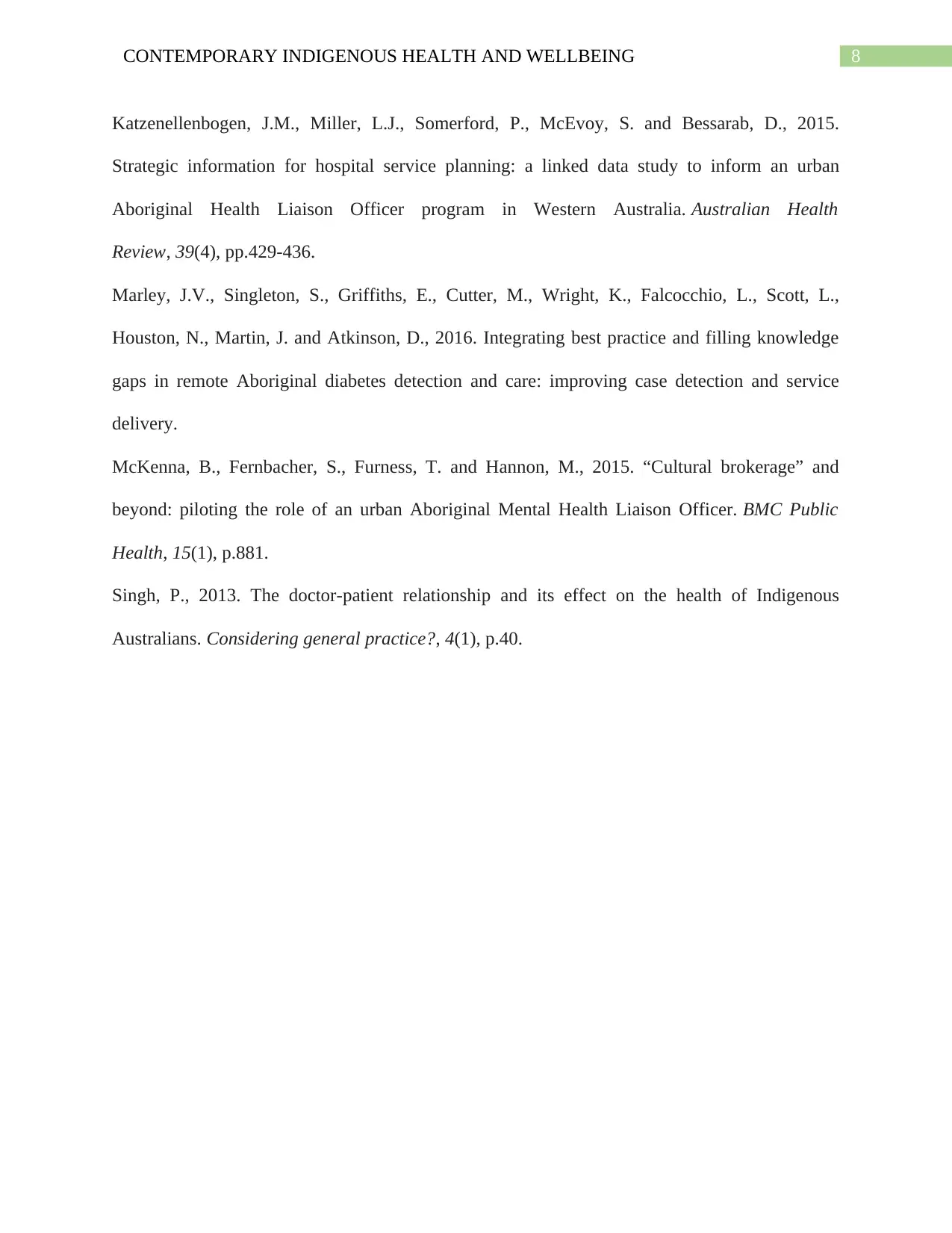
8CONTEMPORARY INDIGENOUS HEALTH AND WELLBEING
Katzenellenbogen, J.M., Miller, L.J., Somerford, P., McEvoy, S. and Bessarab, D., 2015.
Strategic information for hospital service planning: a linked data study to inform an urban
Aboriginal Health Liaison Officer program in Western Australia. Australian Health
Review, 39(4), pp.429-436.
Marley, J.V., Singleton, S., Griffiths, E., Cutter, M., Wright, K., Falcocchio, L., Scott, L.,
Houston, N., Martin, J. and Atkinson, D., 2016. Integrating best practice and filling knowledge
gaps in remote Aboriginal diabetes detection and care: improving case detection and service
delivery.
McKenna, B., Fernbacher, S., Furness, T. and Hannon, M., 2015. “Cultural brokerage” and
beyond: piloting the role of an urban Aboriginal Mental Health Liaison Officer. BMC Public
Health, 15(1), p.881.
Singh, P., 2013. The doctor-patient relationship and its effect on the health of Indigenous
Australians. Considering general practice?, 4(1), p.40.
Katzenellenbogen, J.M., Miller, L.J., Somerford, P., McEvoy, S. and Bessarab, D., 2015.
Strategic information for hospital service planning: a linked data study to inform an urban
Aboriginal Health Liaison Officer program in Western Australia. Australian Health
Review, 39(4), pp.429-436.
Marley, J.V., Singleton, S., Griffiths, E., Cutter, M., Wright, K., Falcocchio, L., Scott, L.,
Houston, N., Martin, J. and Atkinson, D., 2016. Integrating best practice and filling knowledge
gaps in remote Aboriginal diabetes detection and care: improving case detection and service
delivery.
McKenna, B., Fernbacher, S., Furness, T. and Hannon, M., 2015. “Cultural brokerage” and
beyond: piloting the role of an urban Aboriginal Mental Health Liaison Officer. BMC Public
Health, 15(1), p.881.
Singh, P., 2013. The doctor-patient relationship and its effect on the health of Indigenous
Australians. Considering general practice?, 4(1), p.40.
1 out of 8
Related Documents
Your All-in-One AI-Powered Toolkit for Academic Success.
+13062052269
info@desklib.com
Available 24*7 on WhatsApp / Email
![[object Object]](/_next/static/media/star-bottom.7253800d.svg)
Unlock your academic potential
Copyright © 2020–2025 A2Z Services. All Rights Reserved. Developed and managed by ZUCOL.




